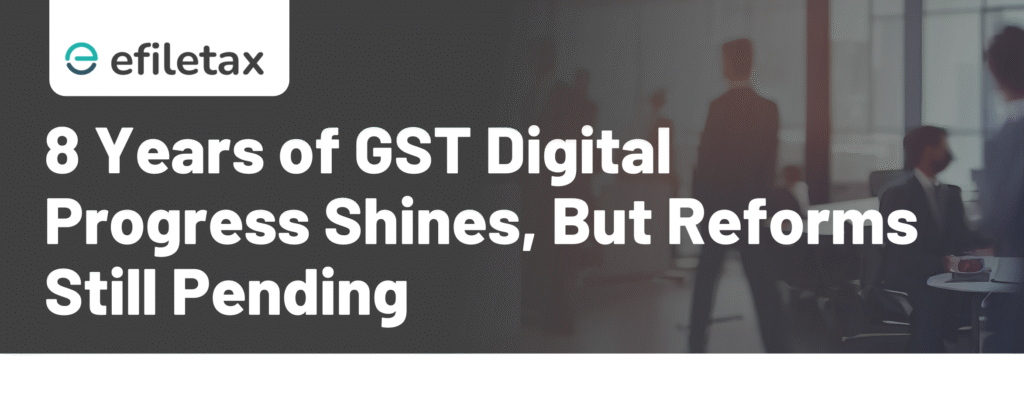
Eight Years of GST Digital Gains Strong, But Reform Remains Key
India’s Goods and Services Tax (GST) completed eight years on 1st July 2025. The unified indirect tax reform has transformed India’s tax landscape — especially in digitisation, compliance, and revenue buoyancy. But despite the visible progress, core reform gaps remain.
Let’s decode what the eight-year journey of GST looks like for Indian businesses, taxpayers, and policymakers — with verified data and expert insight.
GST in 2025: How Far We’ve Come
1. Seamless Input Tax Credit (ITC)
- Automated matching of GSTR-1 and GSTR-3B
- E-invoicing from ₹5 crore turnover onwards
- Real-time invoice data = faster refunds
2. Strong Revenue Growth
- ₹1.86 lakh crore in gross GST collection (May 2025)
- 12% YoY growth – consistent upward trend
- IGST settlements more timely and accurate
3. Massive Digitisation Push
- E-way bill system pan-India
- E-invoice + E-ledger = transparency
- GSTR-9 auto-fill, GSTR-2B insights for better filing
Keyphrase Subheading: Eight Years of GST – What Still Needs Fixing
While the eight years of GST have delivered digital wins, the system still faces structural hurdles:
1. Appellate Backlog
- GSTAT was notified only in 2024
- Appeals pending due to no tribunal since 2020
- Many taxpayers stuck without resolution mechanism
2. Inverted Duty Structure Issues
- Refund delays for textiles, pharma, EV sectors
- Working capital stuck due to blocked credits
- Budget 2025 did not fully resolve this
3. Frequent Rule Changes
- Over 400 circulars and 500+ notifications since 2017
- SMEs and consultants struggle to keep pace
- Ambiguity in rules like Rule 88D, Rule 37A
4. State-Centre Coordination
- Compensation cess issues remain
- Some states seek more say in GST Council decisions
- IT infra uneven across states = compliance friction
GST Revenue Trend Table (2017–2025)
| Financial Year | Total GST Collected | YoY Growth |
|---|---|---|
| FY 2017-18 | ₹7.41 lakh crore | – |
| FY 2018-19 | ₹11.77 lakh crore | +59% |
| FY 2019-20 | ₹12.22 lakh crore | +4% |
| FY 2020-21 | ₹11.36 lakh crore | -7% (COVID) |
| FY 2021-22 | ₹14.83 lakh crore | +31% |
| FY 2022-23 | ₹18.10 lakh crore | +22% |
| FY 2023-24 | ₹20.15 lakh crore | +11% |
| FY 2024-25* | ₹22.35 lakh crore | +10.9% |
*Provisional estimates based on April–May 2025 trend.
Source: PIB GST Revenue Releases
Expert View: A Balanced Scorecard Approach Needed
“GST has matured in infrastructure and digital transparency. But procedural complexity and legal uncertainty are the real pain points now.”
— CA N. Karthikeyan, Indirect Tax Consultant
What Businesses Should Focus On
Regular Reconciliation
- Use GSTR-2B and GSTR-3B for ITC match
- Leverage automation tools
Know Tribunal Status
- Track your state’s GSTAT bench (check gst.gov.in)
- File appeals early to avoid limitation issues
Budget for Working Capital
- Refunds still face delays under inverted duty
- Plan cash flow around export credits and ITC blocks
FAQs – Eight Years of GST
Q1. What is the biggest success of GST?
The integration of multiple indirect taxes into one, supported by a strong digital backend like e-invoicing and e-way bills.
Q2. What’s the current threshold for mandatory e-invoicing?
₹5 crore turnover from 1st April 2025 (as per Notification No. 10/2023 – Central Tax).
Q3. Is GST Appellate Tribunal functional now?
Yes, tribunals are being set up post-GSTAT Procedure Rules, 2024. Some states are still pending notification.
Final Thoughts: Reform the Rules, Not Just the Tech
The eight years of GST have shown that technology can fix paperwork — but not policy confusion. The road ahead requires:
- Tribunal justice
- Simplified returns
- Stable policy framework
Need help filing your GST returns, reconciling ITC, or resolving notices?
👉 Talk to Efiletax experts today
Summary
Eight years of GST have boosted India’s digital tax systems and revenue, but refund delays, appellate backlogs, and complex rules remain. Reforms are still key.